From August 10 till September 5, 128 chessplayers will descend on the Norwegian city of Tromsø to contest the FIDE World Cup. Only two of the best players will be missing: the world champion Vishy Anand of India and his challenger Magnus Carlsen of Norway. They will play for the world crown in November.
Ever since he became the world's top rated grandmaster, Carlsen has been responsible for the chess boom in his native country. Next year in August Norway will also organize the Chess Olympiad in Tromsø.

Some people may think that my connection to Norwegian chess is my having pronounced Magnus Carlsen "The Mozart of Chess" in January 2004 in my Washington Post column. But it goes way back. Let's meet some players from the pre-Magnus era.
Things started to look brighter in Norway with the appearance of Simen Agdestein. He almost won the Junior World championship in Gausdal in 1986, played at nine olympiads, mostly on the top board. He also played soccer for the national team until a knee injury forced him out. His brother Espen, also a member of the olympiad team, is now Carlsen's manager. Simen was one of Carlsen's first coaches.
A half century ago, during my first international tournament, the 1963 Zonal in Halle, Germany, I played against two Norwegians. Svein Johannessen was Norway's top player in the period 1960-70. He was known for chasing the Spanish bishop to death (1.e4 e5 2.Nf3 Nc6 3.Bb5 a6 4. Ba4 b5 5.Bb3 Na5) and scoring many points. He even dared to spring it on Bobby Fischer in Havana in 1966.
Brilliancy and best game prize
The second player in Halle was Per Ofstad, a talented attacker with a plethora of wild ideas. I was able to use Ofstad's pawn sacrifice two years later against the Soviet master German Khodos at the 1965 Student olympiad in Sinaia, Rumania.
The game won the prize for the most beautiful/ best game. It was the second time I won this award at the Student olympiads, both times against Soviet players. My game with Edward Gufeld became my signature game.
From all the sacrifices Khodos chose to accept only the Ofstad's pawn. He avoided other sacrifices - mostly deflections - of both knights, a bishop, a rook and a queen that were part of the game. When I finally forced him to take something, he resigned.
Kavalek - Khodos
Student olympiad, Sinaia 1965
1.e4 c5 2.Nf3 e6 3.d4 cxd4 4.Nxd4 a6 5.Nc3 Qc7
Played already around the 1880s by Wilfried Paulsen, black prevents the advance e4-e5 and for the time being keeps the diagonal a3-f8 open. Theoretical manuals often mistakenly credit Wilfried's more famous brother Louis with the invention of this defense.
6.Be3
In one of the Paulsen variation's first games, Schottlaender,A - Paulsen,W, Leipzig 1879, black demonstrated how effectively his forces can be deployed: 6.a3 b5 7.Be3 Nf6 8.Bd3 Bb7 9.f3 Bc5 with a good game. Khodos had a similar idea in mind.
6...Nf6 7.Bd3 b5?!
Another pawn move. Too many pawn moves, neglecting the development of the pieces, are the drawbacks of the Paulsen line. 7...Nc6 is more solid.
8.e5!?
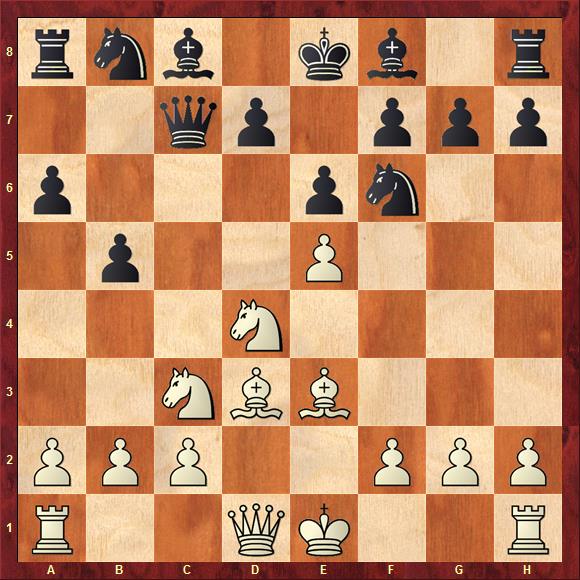
Per Ofstad's idea could be the refutation of black's play. White sacrifices a pawn for a quick development.
8...Qxe5 9.Qf3 d5 10.0-0-0
When the rooks get connected, the opening stage is over. It can be done in eight moves, but 10 moves it is still pretty quick.
10...Bd6?
Locking up the queen in the center leads to disaster. I didn't expect such a gift from a strong Soviet player. Khodos probably wanted to prevent 11.Bf4 and hoped to exchange queens with Qe5-h5.
Chasing the white queen immediately does not work. White has an escape square: 10...Qh5 11.Qg3 Qg4 12.Qc7! with a winning advantage. For example 12...Nbd7 13.h3 Qxg2 14.Rdg1 wins; or 13...Qh5 14.Nc6 Be7 15.Bc5! is a fancy way to win.
I was expecting 10...b4 11.Na4 Qc7. In the original game Ofstad-Malich, Halle 1963, black retreated immediately 10...Qc7. It continued: 11.Rhe1 Be7 12.Bg5 0-0 13.Nf5! - as we will see later, Ofstad enjoyed this move on numerous occasions - 13...Bd8 14.Nxg7! Kxg7 15.Bf4 Qb7 and now instead of 16.g4, he should have played 16.Qh3! with a strong attack.
11.g4
Tightening the net around black's queen.
11...Bb7 12.Qh3
White threatens to win the queen with 13.f2-f4, gaining more time for the attack. Khodos has to retreat.
12...Be7 13.f4 Qc7 14.g5 Ne4 15.Bxe4
The knight has to be taken precisely this way to retain the speed of the attack.
15...dxe4 16.g6! (D)
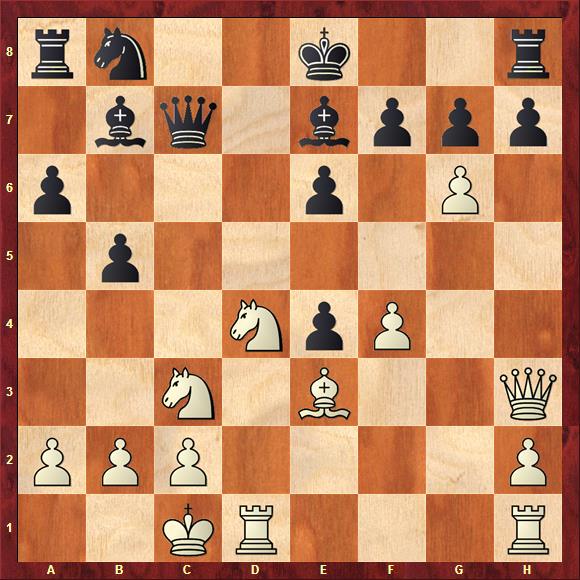
Preventing castling and undermining the pawn on e6. After 16...0-0? 17.Qxh7 mate, but the threat is 17.Qh3xh7! anyway, since after 17...Rxh7 18.gxh7 nobody is going to stop 19.h8Q.
16...fxg6
After 16...Bf6 White can simply play 17.gxf7+ with a decisive advantage either after 17...Qxf7 18.Nxe6; or after 17...Kxf7 18.Qxe6+ Kf8 19.Qxf6+! winning.
However, during the game I was attracted to a double knight sacrifice:
17.Nxe6!? fxe6 18.Nxe4!
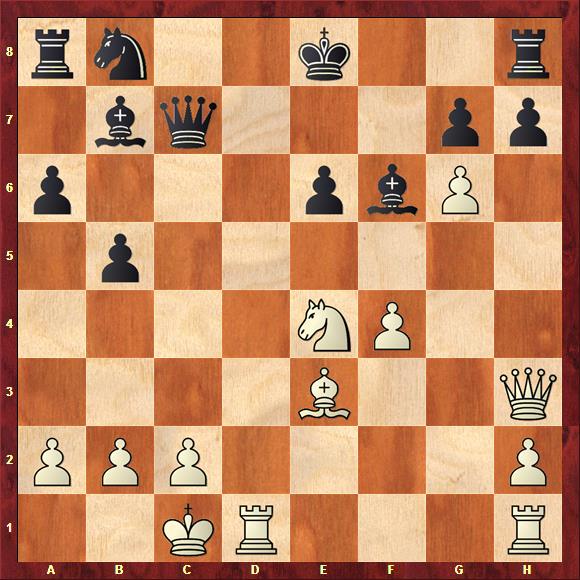
It leads to pretty finishes, for example:
A. 18...Bxe4 19.Qxe6+ Kf8 20.Bc5+ Qxc5 21.Qf7 mate.
B. 18...Bd5 19.Rxd5! exd5 20.Qe6+ Be7 21.Nf6+! gxf6 22.g7! Rf8 23.gxf8Q+ Kxf8 24.Rg1 wins; or 20...Qe7 21.Nxf6+ gxf6 22.Qc8+ Qd8 23.g7! wins.
C. 18...Nd7 19.Qxe6+ Be7 20.Nf6+! gxf6 21.Qf7+ Kd8 22.g7 wins.
17.Nxe6
As they say, the knight anchored on the sixth rank is a monster. It limits the movement of the black king.
17...Qc8 18.f5!
A consistent way to attack, leading to a nice finish. White wants to open the f-file.
18...Kf7
After 18...gxf5 19.Qxf5 Bf6 20.Nxg7+! Bxg7 21.Qh5+ Ke7 22.Bc5+ wins.
19.fxg6+ hxg6 20.Rhf1+ Bf6
Black doesn't have a good defense. After 20...Kg8 21.Qg4 Qe8 [or 21...Nc6 22.Qxg6 Rh7 23.Rf7 Bf6 24.Nxe4+-] white wins with 22.Nxg7!, for example:
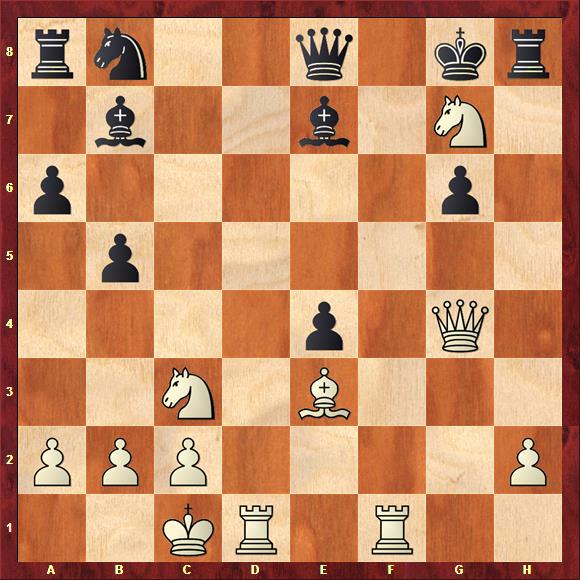
A. 22...Kxg7 23.Bd4+ Kg8 24.Qe6+ Kh7 25.Qh3+ Kg8 26.Qxh8 mate.
B. 22...Rh4 23.Qe6+ Kxg7 24.Rd8! Qxd8 25.Rf7+ Kh8 26.Qxg6 Bf6 27.Bh6 wins.
C. 22...Bc8 23.Qxe4 Kxg7 24.Rd6! Bf5 25.Bd4+ Kh7 [or 25...Kg8 26.Rxf5!+-] 26.Rxf5! wins.
21.Ng5+ Kg8
The final fireworks are based on multiple deflections. The winning queen sacrifice is around the corner. After 21...Ke7 the bishop deflects the black queen and white mates: 22.Bc5+! Qxc5 23.Qe6+ Kf8 24.Rd8 mate.
22.Rd8+!
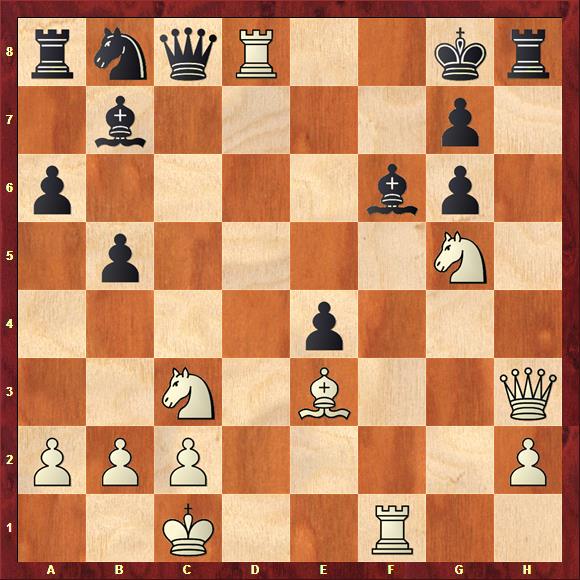
After 22...Qxd8 23.Qe6+ Kf8 24.Qf7 mates; and after 22...Bxd8 the queen sacrifice decides: 23.Qxh8+! Kxh8 24.Rf8 mate.
Black resigned.
Actually, Khodos was trying to resign when my sliding rook was passing the square d5, but he let me finish my move.
Ofstad's astonishing mate
If there ever was a chess troll, surprising players when they least expected it, it must have been Per Ofstad. The 1961 champion of Norway claimed many victims with his flamboyant style. He looked serious, sometimes sad, when there was nothing to sacrifice. But give him active pieces and his mood would change immediately. Correct or not, his attacks had flair. His ideas and combinations were stunning. Wolfgang Uhlmann would certainly remember the game against him from Halle. He could have claimed a draw, but got greedy and Ofstad finished the game with a beautiful pure mate.
Ofstad - Uhlmann
Halle zt 1963
1.e4 e6 2.d4 d5 3.Nd2 c5 4.exd5 Qxd5 5.Ngf3 cxd4 6.Bc4 Qd6 7.0-0 Nc6 8.Re1 a6 9.a4 Qc7 10.Ne4 Bd7 11.Nxd4 Be7 12.Nf5!
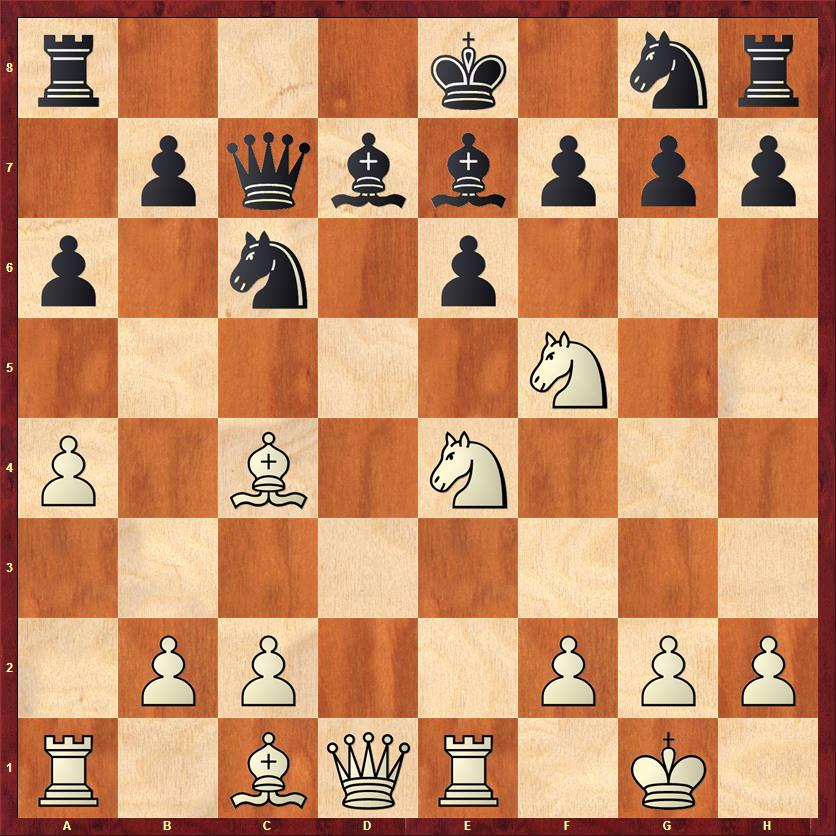
Ofstad's favorite knight leap makes the computers blush.
12...exf5 13.Nd6+ Kf8 14.Nxf7 Be8 15.Qd5
Diving into complications. 15.Nxh8 Rd8 is roughly equal.
15...Qa5
Uhlmann tries for more. He could have settled for a draw with 15...Nf6 16.Ng5! Qd6! [16...Nxd5? 17.Ne6+ wins.] 17.Ne6+ Kg8 18.Qxd6 Bxd6 19.Ng5+ Kf8 20.Ne6+ Kg8 [20...Ke7 21.Nc7+] 21.Ng5+ (21.Nc7+ Bf7) 21...Kf8 22.Ne6+=;
But not 15...Rd8 16.Nxd8 Nxd8 17.Qxf5+ Nf6 18.b3 and white wins.
16.Qe6 Nd4
After 16...Bd7 17.Qe2 Nd4 18.Qd1 Nxc2? 19.Bd2 white wins.
17.Ng5

17...Bxg5?
A losing blunder. Taking the queen leads to a draw: 17...Nxe6 18.Nxe6+ Kf7 19.Nf4+ Kf8 20.Ne6+=.
18.Qd6+ Be7 19.Rxe7!
Uhlmann resigned, not waiting for the beautiful mate:19...Nxe7 20.Qf6+!! gxf6 21.Bh6 mate.
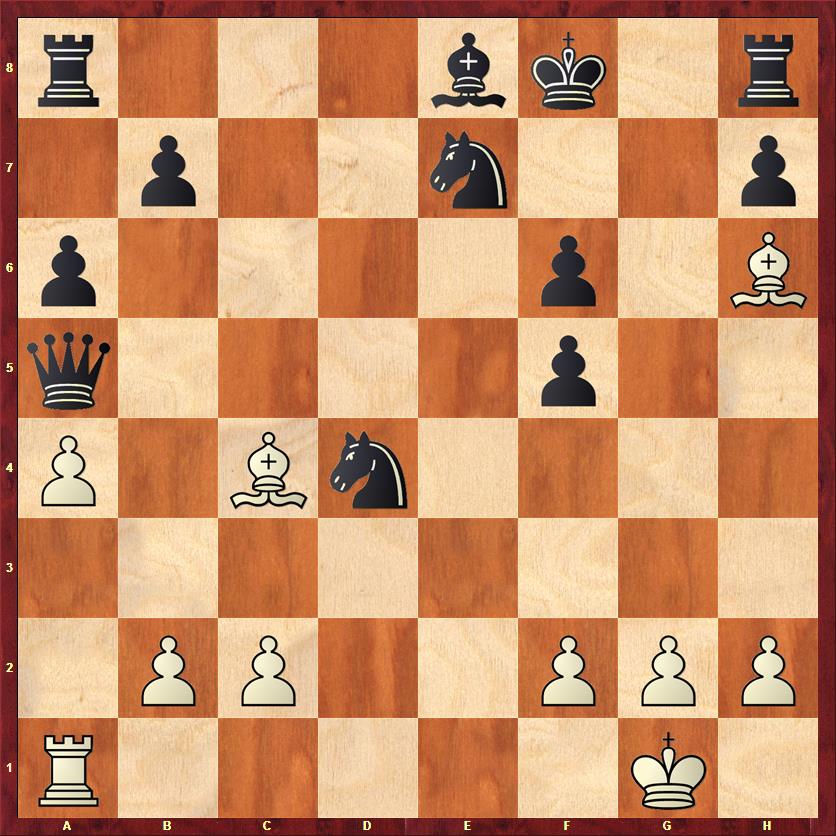
Note that in the replay windows below you can click either on the arrows under the diagram or on the notation to follow the game.
Image by Bård Løken
